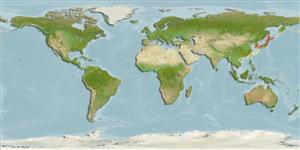>
Pleuronectiformes (Flatfishes) >
Pleuronectidae (Righteye flounders) > Pleuronectinae
Etymology: Lepidopsetta: Greek, lepis = scale + Greek, psetta = grouper (Ref. 45335); mochigarei: Specific name refers to the bright white blind side similar to white rice-cake common in Japan.
Eponymy: This is not an eponym but a Japanese name meaning ‘rice-cake flounder’ (mochi = Japanese rice cake traditionally eaten at New Year). (Ref. 128868), visit book page.
More on author: Snyder.
Environment: milieu / climate zone / depth range / distribution range
Ecologia
marino demersale. Temperate
Northwest Pacific: Korean Peninsula to the southern Sea of Okhotsk.
Size / Peso / Age
Maturity: Lm ? range ? - ? cm
Max length : 40.0 cm SL maschio/sesso non determinato; (Ref. 559)
Short description
Chiavi di identificazione | Morfologia | Morfometria
Blind side white, with glossy highlights along myotome margins, increasing anteriorly. Pores: supraorbital 1-3; preopercular 8-13; lateral line 95-119. Interorbital space narrow (Ref. 37594).
Life cycle and mating behavior
Maturità | Riproduzione | Deposizione | Uova | Fecundity | Larve
Vinnikov, K.A., R.C. Thomson and T.A. Munroe, 2018. Revised classification of the righteye flounders (Teleostei: Pleuronectidae) based on multilocus phylogeny with complete taxon sampling. Molecular phylogenetics and evolution, 125:147-162. (Ref. 122998)
IUCN Red List Status (Ref. 130435: Version 2024-2)
Threat to humans
Harmless
Human uses
Pesca: commerciale
Strumenti
Special reports
Download XML
Fonti Internet
Estimates based on models
Preferred temperature (Ref.
123201): 5.7 - 20.5, mean 11.4 °C (based on 305 cells).
Phylogenetic diversity index (Ref.
82804): PD
50 = 0.6250 [Uniqueness, from 0.5 = low to 2.0 = high].
Bayesian length-weight: a=0.00912 (0.00453 - 0.01836), b=3.10 (2.93 - 3.27), in cm total length, based on LWR estimates for this (Sub)family-body shape (Ref.
93245).
Trophic level (Ref.
69278): 3.2 ±0.2 se; based on size and trophs of closest relatives
Resilienza (Ref.
120179): Basso, tempo minimo di raddoppiamento della popolazione 4.5 - 14 anni (Preliminary K or Fecundity.).
Fishing Vulnerability (Ref.
59153): Moderate vulnerability (39 of 100).
Nutrients (Ref.
124155): Calcium = 35.2 [14.2, 61.8] mg/100g; Iron = 0.264 [0.135, 0.508] mg/100g; Protein = 16.8 [15.4, 18.1] %; Omega3 = 0.363 [0.180, 0.760] g/100g; Selenium = 19.7 [10.1, 41.4] μg/100g; VitaminA = 10.6 [2.5, 43.9] μg/100g; Zinc = 0.492 [0.332, 0.718] mg/100g (wet weight);
